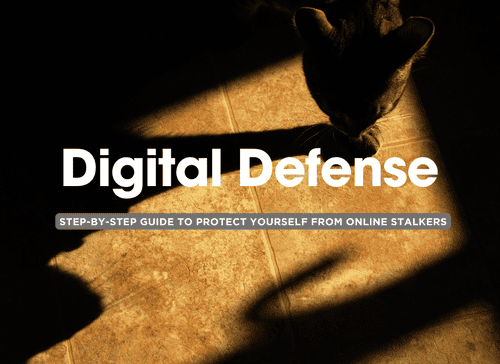Dealing with an online stalker can feel overwhelming and invasive, especially if they’re continually trying to contact you, monitoring your social media, or harassing you through messages. While it’s natural to feel uncomfortable, there are effective steps you can take to protect yourself and regain control of your online space. Here’s a friendly, straightforward guide to handling an online stalker, so you can safeguard your digital life and find some peace of mind.
1. 🚫 Block and Restrict Communication Channels
- Explanation: The first step in dealing with an online stalker is to cut off their access to you. Blocking them on all platforms prevents them from directly contacting or viewing your content. Many social media platforms and messaging apps offer additional features like “Restrict,” which limits their visibility and keeps them from knowing you’ve blocked them.
- Why It Helps: Blocking removes their immediate access and makes it harder for them to contact you, taking away their power to intrude on your space.
- Pro Tip: Go through each of your social media accounts, email, and messaging apps, and block the stalker on every platform. This includes less obvious channels like LinkedIn or even Venmo.
2. 🔒 Strengthen Privacy Settings
- Explanation: Tightening up your privacy settings can prevent the stalker from viewing your posts, stories, or personal information. Many social media sites allow you to hide your profile from people who aren’t on your friend list, limit who can see your past posts, and even control who can search for you.
- Why It Helps: Making it harder for the stalker to access information about you reduces their ability to keep track of your activity and feel “connected” to you.
- Pro Tip: Set your profiles to private, limit visibility of past posts, and restrict who can tag you in content. On Facebook, for instance, you can also disable friend requests from people who aren’t connected to you.
3. 🕵️ Monitor Your Digital Footprint
- Explanation: Your digital footprint consists of the traces you leave online, from social media posts to public profiles on various websites. Regularly searching for your own name can help you understand what information is publicly available and whether the stalker might have access to anything sensitive.
- Why It Helps: Knowing your digital footprint allows you to see what others can see and helps you take steps to remove or control sensitive information.
- Pro Tip: Google yourself and look for any public profiles, past posts, or images that might be accessible. If needed, reach out to sites or use tools like Google’s removal request to reduce visibility of any compromising content.
4. 🔍 Keep Track of Evidence
- Explanation: Documenting interactions with the stalker is crucial, especially if the situation escalates. Take screenshots of messages, emails, or any suspicious activity. Even if you block them, keeping a record can provide essential evidence if you need to report the behavior.
- Why It Helps: Having documented proof of stalking behavior strengthens your case if you decide to involve authorities or report the harassment to the platform.
- Pro Tip: Create a dedicated folder to save screenshots, emails, and any related notes. Make sure it’s stored securely, either in a private cloud folder or on a device only you can access.
5. 🛡️ Avoid Engaging with the Stalker
- Explanation: It can be tempting to confront or ask the stalker to stop, but engagement often encourages them, as it shows that they’re getting a reaction from you. Ignoring them is often the most effective approach, as it denies them the attention they’re seeking.
- Why It Helps: Not responding or engaging reduces their incentive to continue and helps you maintain control over your emotions and responses.
- Pro Tip: Avoid posting any indirect messages aimed at them, too. It’s best not to give any indication that you’re affected by their actions, as even indirect responses can fuel their behavior.
6. 🛠️ Secure Your Accounts
- Explanation: Stalkers may try to access your accounts directly by guessing passwords or using security questions to gain entry. Strengthen your accounts with unique, complex passwords and enable two-factor authentication (2FA) to ensure they stay secure.
- Why It Helps: Enhanced security makes it significantly harder for the stalker to access your accounts, giving you peace of mind that your information is safe.
- Pro Tip: Use a password manager to generate and store complex passwords for each account, and activate 2FA on all platforms that support it, like email, social media, and banking.
7. 🕹️ Limit Shared Information Carefully
- Explanation: Be mindful of what you share online, even with close friends. Stalkers often find information through mutual connections or by monitoring your public posts. Avoid sharing details like your location, daily routines, or plans on social media.
- Why It Helps: Reducing publicly available information limits what the stalker can track, protecting your privacy and making it harder for them to follow your activities.
- Pro Tip: Consider using private messaging to share personal details with trusted people rather than posting them publicly. Also, adjust settings to limit who can see your posts and who can tag you.
8. 🛂 Report the Stalker to Platforms and Authorities if Necessary
- Explanation: If the stalker persists despite your efforts, don’t hesitate to report them to the platform you’re being harassed on. Most social media sites have harassment policies in place and may suspend or ban the stalker’s account. If the stalking escalates or you feel threatened, contacting local authorities is also an option.
- Why It Helps: Reporting the stalker creates a formal record of their actions and can result in action taken against them, providing an added layer of protection.
- Pro Tip: When reporting, include any evidence you’ve gathered, such as screenshots and detailed descriptions of the harassment, to strengthen your case.
Handling an online stalker can be a stressful experience, but taking these steps can help you regain control and protect your online presence. Remember, you’re not alone, and there are tools and support systems available to help you manage the situation. By staying vigilant, securing your accounts, and limiting information sharing, you can create a safer online space for yourself. Stay safe, and remember that taking action now can make a big difference in maintaining your privacy and peace of mind.



